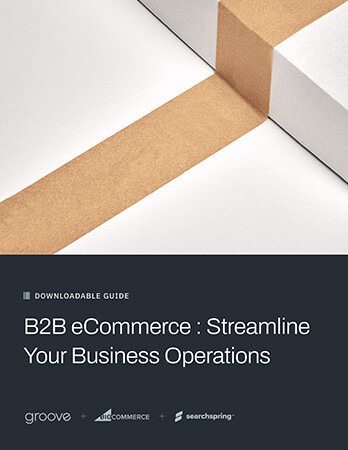Introduction
The explosive growth of wholesale B2B eCommerce is transforming how businesses operate in the wholesale industry. Valued at over $30 trillion in 2024, the global B2B eCommerce market is growing faster than B2C, with a compound annual growth rate (CAGR) of over 16 percent. This shift underscores the importance of adopting eCommerce for wholesalers that want to stay competitive and cater to digitally savvy B2B buyers. With tools like AI, predictive analytics, and robust eCommerce platforms, businesses can streamline operations, expand their reach, and deliver superior customer experiences.
This blog post explores the nuances of wholesale eCommerce, explaining the most important challenges, opportunities, and strategies for success.
Understanding Wholesale B2B eCommerce
What Is Wholesale B2B eCommerce?
Wholesale eCommerce refers to the digital transformation of traditional wholesale transactions. Unlike B2C eCommerce, which targets consumers, B2B eCommerce connects wholesalers with retailers, manufacturers, or other business clients via online platforms. This shift from manual processes to digital channels enables real-time order processing, inventory management, and personalized pricing.
For instance, a supplier selling industrial parts to manufacturers can automate bulk ordering processes, reducing manual errors and saving time.
Why Wholesale Businesses Need eCommerce
The transition to eCommerce is critical for wholesale businesses because of several significant benefits:
- Global Reach: eCommerce eliminates geographical limitations, allowing wholesalers to serve international markets.
- Streamlined Operations: From order processing to delivery tracking, technology reduces inefficiencies.
- Enhanced Customer Experience: Self-service portals and personalized recommendations empower B2B buyers to make informed decisions without delay.
The Growth of Wholesale B2B eCommerce
Market Trends and Projections
The wholesale B2B eCommerce sector is booming. Retail supply chains and manufacturing industries are leading this charge:
- The B2B eCommerce market’s value is projected to reach $66 trillion by 2029.
- Manufacturers, distributors, and technology providers are increasingly leveraging eCommerce to optimize supply chains.
Factors Driving Growth
Key factors contributing to the rise of eCommerce include:
- Cloud-Based Solutions: Cloud platforms simplify operations and ensure scalability.
- Personalized Buying Experiences: AI-driven tools offer tailored product recommendations.
- Data Analytics: Real-time insights into purchasing patterns enable better decision-making.
Impact of the Pandemic
COVID-19 acted as a catalyst for eCommerce adoption. Wholesalers pivoted to digital platforms to counter supply chain disruptions, leading to a surge in online B2B transactions.
Challenges and Opportunities in Wholesale B2B eCommerce
Common Challenges
- Managing Bulk Inventory: Tracking and replenishing large quantities across SKUs
- Customized Pricing: Creating dynamic pricing for different customers
- System Integration: Ensuring ERP, CRM, and PIM systems work seamlessly
- Digital Competency: Catering to a diverse audience with varying tech skills
Emerging Opportunities
- AI for Personalization: AI-based platforms predict customer needs and offer tailored solutions.
- Expanding Into New Markets: Scalable platforms like Shopify Plus and BigCommerce enable wholesalers to serve global markets efficiently.
Choosing the Right B2B eCommerce Platform
Key Features to Look For
When selecting an eCommerce platform, consider:
- Scalability: To handle growing transaction volumes
- Bulk Ordering Support: Features like custom pricing and tiered discounts
- Integration: Seamless ERP, CRM, and PIM integrations for efficient management
Platform Comparison
Shopify Plus, BigCommerce, and Magento 2 rank among the top contenders:
- Shopify Plus excels in user experience and ease of customization.
- BigCommerce supports advanced integrations for inventory and pricing.
- Magento 2 offers flexibility but requires greater technical expertise.
Enhancing the B2B eCommerce Experience
Optimizing for Self-Service
Modern B2B buyers increasingly prefer self-service options because they value convenience and speed in their purchasing journeys. To cater to these preferences, eCommerce wholesale businesses must prioritize user-friendly interfaces and robust capabilities:
- Intuitive Search Tools: Advanced search features with filtering options, autocomplete, and relevancy ranking will enable buyers to quickly locate the products they need, even in an extensive catalog.
- Account Management Portals: These portals allow buyers to easily reorder previous purchases, manage shipping addresses, and view transaction histories. For repeat buyers, these features streamline the workflow, saving time and reducing errors.
- Live Chat Support: By implementing a live chat system, you can bridge the gap between self-service and customer support. For example, long-time customers who hesitate to transition away from phone orders can receive real-time assistance, instantly addressing concerns or technical issues. This improves conversion rates and minimizes cart abandonment.
Personalized Customer Accounts
Personalization extends far beyond greeting customers by name. By leveraging AI and machine learning, businesses can enhance customer accounts to deliver truly tailored experiences:
- Customized Pricing: Individual account settings can incorporate negotiated pricing, volume-based discounts, or exclusive promotions. This ensures that loyal customers and bulk buyers are automatically rewarded for their contributions.
- Predictive Product Recommendations: AI analyzes purchasing patterns to suggest products that customers are likely to need. This benefits upselling and cross-selling efforts. For instance, a buyer who orders industrial components might receive suggestions to purchase complementary tools or replacement parts.
- Automated Reordering: Streamlining reorders for frequently purchased items will simplify procurement for clients. Automated alerts and one-click reordering features eliminate repetitive steps while enhancing buyer satisfaction.
Streamlining Checkout and Payments
A clunky checkout process can deter even the most loyal customers. To address this problem, businesses must focus on providing efficient, seamless payment solutions:
- Diverse Payment Options: Payment methods like ACH transfers, purchase orders, and credit terms cater to varying business needs. Some B2B clients favor deferred payment options, and accommodating these preferences will enhance trust and flexibility.
- Integrated Tax and Shipping Calculators: Real-time calculators provide transparency by showing accurate tax and shipping costs before checkout. This prevents surprises and helps businesses build credibility.
- Multi-Currency Support: For wholesalers that target international markets, it’s possible to create a frictionless experience by accepting payments in local currencies and displaying prices in relevant formats.
- Guest Checkout: A guest checkout option will ensure that first-time buyers can place orders without the hassle of creating an account. This improves initial conversion rates.
Emerging Trends in Wholesale B2B eCommerce
AI and Predictive Analytics
Artificial intelligence and predictive analytics are revolutionizing wholesale eCommerce by empowering businesses to anticipate needs and enhance operational efficiency:
- Demand Forecasting: AI algorithms analyze historical sales data, seasonal trends, and external factors to predict inventory needs. This minimizes stockouts and overstocking.
- Customer Insights: Predictive tools identify purchasing patterns and preferences, allowing businesses to offer timely and relevant recommendations or promotions.
- Operational Automation: From managing inventory to processing routine orders, AI eliminates manual errors and reduces costs, freeing up resources for strategic initiatives.
Omnichannel Integration
Omnichannel integration ensures a seamless experience across all touchpoints, blending online and offline interactions:
- Unified Catalogs: Customers who access products through physical locations, mobile apps, and websites see consistent product details and pricing.
- Real-Time Syncing: Inventory, order status, and customer preferences are updated instantly across all channels, enabling businesses to deliver cohesive experiences.
- Click-and-Collect: Buyers can place orders online and pick them up at physical locations, combining the convenience of eCommerce with the immediacy of traditional shopping.
Sustainability in Supply Chains
Sustainability is no longer optional; it's a critical component of modern eCommerce strategies:
- Digital-First Operations: By reducing reliance on paper-based processes, eCommerce platforms contribute to eco-friendly practices.
- Optimized Shipping: By grouping orders and optimizing delivery routes, you can minimize your carbon footprint.
- Ethical Sourcing: Platforms can highlight suppliers that meet environmental and ethical standards, aligning with customer values.
Mobile Optimization
With over 50 percent of B2B buyers now relying on mobile devices for business transactions, mobile optimization is crucial:
- Responsive Design: Websites must adapt seamlessly to various screen sizes, ensuring usability across devices.
- Mobile-Friendly Payment Options: You can improve checkout experiences by using simplified payment gateways that are compatible with mobile platforms.
- App-Based Solutions: Dedicated apps offer additional functions, such as offline catalog access and instant order notifications.

Our free performance and accessibility audit can evaluate your website to determine what pages or features need optimization.
Strategies for B2B eCommerce Success
Marketing Automation
Marketing automation tools empower businesses to stay engaged with their clients, nurturing relationships at scale:
- Email Campaigns: Drip campaigns can educate customers about new products, remind them of upcoming reorders, or promote exclusive deals.
- SMS Alerts: Instant notifications about orders, discounts, and shipping provide a personal touch and improve communication.
- Personalized Outreach: Automation can segment clients based on purchase history, ensuring they receive tailored messages that resonate with their needs.
Data-Driven Decisions
Analytics play a pivotal role in refining B2B strategies:
- Identifying High-Value Customers: By analyzing order history and frequency, businesses can focus on nurturing relationships with top buyers.
- Optimizing Pricing Strategies: Real-time data helps companies experiment with tiered pricing, discounts, or dynamic pricing models that maximize profitability.
- Improving Product Offerings: When businesses determine what items sell best (or underperform), they can adjust their inventory mix based on demand.
Customer Support
Reliable customer service helps differentiate the best eCommerce businesses:
- Live Chat Assistance: Addressing queries in real time will improve customer satisfaction and build trust.
- 24/7 Chatbots: AI-driven chatbots ensure round-the-clock availability. Chatbots assist buyers with common issues and guide them through routine processes.
- Dedicated Support Teams: When a knowledgeable support team is familiar with client needs and how to address them, it adds a valuable human element to the digital experience.

See our case study on Strobels Supply to discover how we helped the company succeed as an eCommerce wholesale business.
Conclusion
Wholesale B2B eCommerce is reshaping the wholesale industry. By adopting the right tools, platforms, and strategies, businesses can overcome challenges and unlock new opportunities. If you're ready to take your eCommerce operations to the next level, Groove Commerce is here to guide you. Check out our B2B eCommerce services or contact us today!

eBook
B2B eCommerce: The Complete Guide to Accelerate Growth
Explore tags:
About the author
Subscribe to the Groove Newsletter
Get the latest updates and insights straight to your inbox






